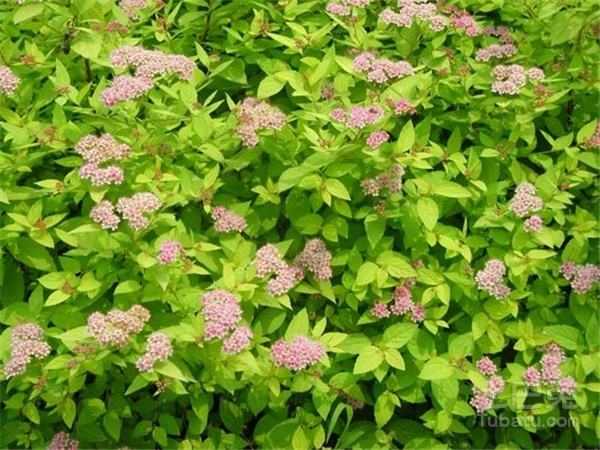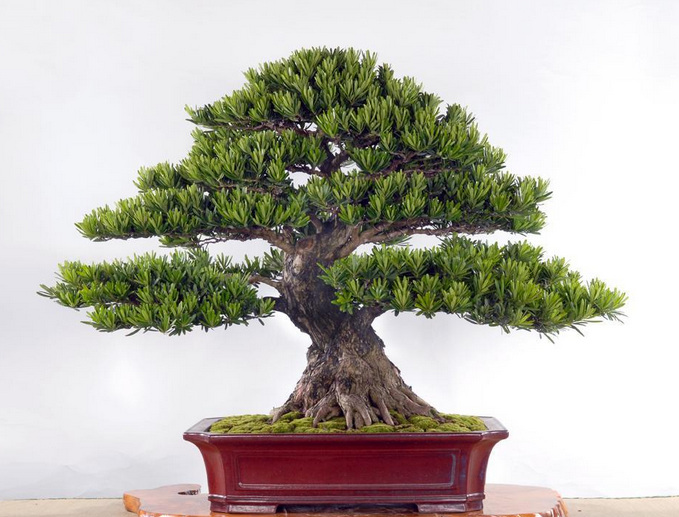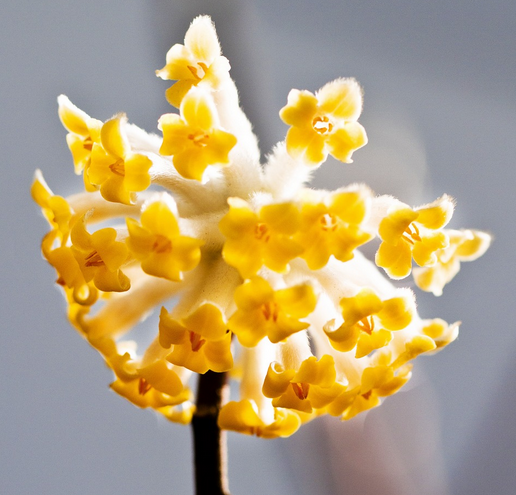Small potted plants and great knowledge, how to raise Fufang vine bonsai
Introduction: Fufang vine is an excellent landscaping plant, which is often used for vertical greening or ground cover plant. The bonsai made with it has strong roots, quaint stems, thick green leaves in spring, summer and early autumn, and red leaves after frost in late autumn. it is a very popular bonsai tree species in the north. Although it is a kind of plant that is easy to survive, there is a lot of knowledge in the production and management of Fufangteng bonsai. It is necessary to take good care of it and take good care of it in order to have a bonsai full of vitality.
1. Growth condition
Fufangteng likes the shady and humid growth environment and is mostly produced in the hillside jungle. Potted plants can be prepared with rotten leaf soil and garden soil mixed with sandy soil, which is warm and hardy, and the suitable temperature for growth is 15-25 degrees.
two。 Layout
Fufang vine plant shape is small, winter leaves turn red, more hardy, more suitable for family viewing. It can be arranged as a climbing plant, as a potted plant on a flower rack, or as a hanging cultivation, allowing it to droop.
3. Four seasons management
(1) Spring is suitable to be arranged on the balcony facing east, south and west. Fufang vine can be placed in a bright place to cultivate in early spring, keep the basin soil moist, and pay attention to spraying water to the leaf surface and around to improve air humidity. The pots were changed from March to April and 5-6 plants were planted in one pot. Fufangteng has strong adaptability and lax requirements on soil, so it is best to use soil rich in humus in basin soil. Spring is the peak growing season, we should pay attention to fertilization, when the soil is barren, the leaves are easy to turn yellowish green.
(2) it is suitable to be arranged on the balcony of the east, south and north in summer. Fufangteng is resistant to high temperature, but afraid of the scorching sun. Strong light is easy to cause scorched edges and curls of leaves, so it should be arranged in places where the light is not strong, keep the basin soil moist, and spray water on and around the leaves several times a day to improve air humidity.
(3) it is suitable to be arranged on the balcony facing east, south and west in autumn. The temperature was gradually moved to a place with light before the temperature dropped in autumn. The water supply can be reduced gradually. After the temperature drops, it should be allowed to experience frost outdoors, so that the leaf color can be brightly colored by the frost.
(4) it is suitable to be arranged on the balcony facing east, south and west in winter. Fufangteng can overwinter in the open field in the south of Qinling Mountains. Potted plants should be planted in the north of Qinling Mountains and move into the cold room in winter. Fufang vine can be moved to watch in the balcony after discoloration. When the indoor temperature is low, it can make the basin soil dry. When the indoor temperature is above 10 ℃, the basin soil should be kept moist.
4. Pruning
Potted seedlings can be topped for 2 or 3 times, allowing them to produce several lateral branches, and then pruned according to their own modeling requirements. For hanging cultivation, but no longer hit the top, allowing it to droop and grow. Do not make hanging cultivation, should continue to top several times, in order to promote its multiple branches, form a full basin.
Flowers and plants are also spiritual. like people, if they take good care of them and take good care of them, they will be in high spirits; if they are careless and careless, they will be lifeless. We can see that Fufang vine bonsai is very sensitive to temperature, light and moisture, and we should pay attention to the changes of various indexes all the year round. Fufang vine has rapid growth and strong germination. It is necessary to prune the plant before germination in spring, and to prune the new branches in early summer to keep the beauty of bonsai.

Small potted plants and great knowledge, how to raise Fufang vine bonsai
Introduction: Fufang vine is an excellent landscaping plant, which is often used for vertical greening or ground cover plant. The bonsai made with it has strong roots, quaint stems, thick green leaves in spring, summer and early autumn, and red leaves after frost in late autumn. it is a very popular bonsai tree species in the north. Although it is a kind of plant that is easy to survive, there is a lot of knowledge in the production and management of Fufangteng bonsai. It is necessary to take good care of it and take good care of it in order to have a bonsai full of vitality.
1. Growth condition
Fufangteng likes the shady and humid growth environment and is mostly produced in the hillside jungle. Potted plants can be prepared with rotten leaf soil and garden soil mixed with sandy soil, which is warm and hardy, and the suitable temperature for growth is 15-25 degrees.
two。 Layout
Fufang vine plant shape is small, winter leaves turn red, more hardy, more suitable for family viewing. It can be arranged as a climbing plant, as a potted plant on a flower rack, or as a hanging cultivation, allowing it to droop.
3. Four seasons management
(1) Spring is suitable to be arranged on the balcony facing east, south and west. Fufang vine can be placed in a bright place to cultivate in early spring, keep the basin soil moist, and pay attention to spraying water to the leaf surface and around to improve air humidity. The pots were changed from March to April and 5-6 plants were planted in one pot. Fufangteng has strong adaptability and lax requirements on soil, so it is best to use soil rich in humus in basin soil. Spring is the peak growing season, we should pay attention to fertilization, when the soil is barren, the leaves are easy to turn yellowish green.
(2) it is suitable to be arranged on the balcony of the east, south and north in summer. Fufangteng is resistant to high temperature, but afraid of the scorching sun. Strong light is easy to cause scorched edges and curls of leaves, so it should be arranged in places where the light is not strong, keep the basin soil moist, and spray water on and around the leaves several times a day to improve air humidity.
(3) it is suitable to be arranged on the balcony facing east, south and west in autumn. The temperature was gradually moved to a place with light before the temperature dropped in autumn. The water supply can be reduced gradually. After the temperature drops, it should be allowed to experience frost outdoors, so that the leaf color can be brightly colored by the frost.
(4) it is suitable to be arranged on the balcony facing east, south and west in winter. Fufangteng can overwinter in the open field in the south of Qinling Mountains. Potted plants should be planted in the north of Qinling Mountains and move into the cold room in winter. Fufang vine can be moved to watch in the balcony after discoloration. When the indoor temperature is low, it can make the basin soil dry. When the indoor temperature is above 10 ℃, the basin soil should be kept moist.
4. Pruning
Potted seedlings can be topped for 2 or 3 times, allowing them to produce several lateral branches, and then pruned according to their own modeling requirements. For hanging cultivation, but no longer hit the top, allowing it to droop and grow. Do not make hanging cultivation, should continue to top several times, in order to promote its multiple branches, form a full basin.
Flowers and plants are also spiritual. like people, if they take good care of them and take good care of them, they will be in high spirits; if they are careless and careless, they will be lifeless. We can see that Fufang vine bonsai is very sensitive to temperature, light and moisture, and we should pay attention to the changes of various indexes all the year round. Fufang vine has rapid growth and strong germination. It is necessary to prune the plant before germination in spring, and to prune the new branches in early summer to keep the beauty of bonsai.
Modeling and maintenance of Fufangteng bonsai
1, Miao Yuan. The propagation of Fufang vine is easy to survive by means of sowing, cutting, striping and so on. Can also be dug out of the mountain for many years, the pile head thick, simple Qiu qu old pile to make bonsai.
2, modeling. The bonsai made by Fufang vine has strong roots, quaint stems, dark green leaves in spring, summer and early autumn, and red leaves in late autumn after frost, which is highly ornamental. It is a promising bonsai tree species. According to the shape of the stump, Fufangteng can be made into straight dry type, oblique dry type, curved dry type, double dry type, water-facing type, water-dry type and other types of bonsai. Because of its developed root system, it is most suitable for making stone-attached or wood-attached bonsai. The canopy can be processed into a properly dense triangle or steamed bread shape, or it can be processed into a distinct layer of clouds. The methods of pruning and flat binding are commonly used for modeling, supplemented by means of pulling and other means to make the branch layout reasonable. For artificially propagated Fufang vine, because the trunk is not thick enough, and lack of old and simple momentum, it can be attached to strange stones or dead tree stumps of suitable shape and size to improve ornamental. The good Fufang vine bonsai can be moved into the viewing basin in spring, and according to the need, the bonsai will be covered with moss, decorated with strange stones and accessories, so that the artistic conception of bonsai will be more far-reaching.
3, maintenance. Fufangteng likes warm, humid and sunny environment, resistant to semi-shade, and has a certain degree of cold resistance. The bonsai can be maintained in an outdoor place with sufficient light, and can be properly shielded from the sun in midsummer to avoid hot sun exposure, otherwise the leaves will be yellowed; during the growing period, watering will not dry, watering thoroughly, and often spray water to the plant when the air is dry, in order to increase air humidity and prevent the edge of the leaf from becoming scorched. Usually should not fertilize too much, in case the leaves become larger, affect the ornamental, once a month to apply mature cake fertilizer can, autumn attention to increase phosphorus, potash fertilizer, in order to promote the frosted leaves become bright red, and prolong the viewing time. Overwintering in cold indoor or outdoor shelter in winter, stop fertilization, control watering, and keep the basin soil not too dry. The overwintering temperature can be about 0 to 5 ℃. According to the specifications of bonsai, the basin is turned every 1 to 2 years, usually in spring, when the basin is turned, most of the soil is removed, the withered roots and over-long old roots are cut off, and then planted with new culture soil. The basin soil should be loose and fertile. Sandy soil with good drainage and permeability. Fufang vine grows rapidly and has strong germination ability. It is necessary to prune the plant before germination in spring and to prune the new branches of the same year in early summer. Cut off useless long branches or other branches that affect the shape of the tree at any time during the growing period, and pay attention to the head and heart, so as to promote the germination of new side branches, make the crown dense and compact, and keep the bonsai beautiful. The main diseases and insect pests of Fufangteng are anthracnose, stem blight, aphids, night moth and so on. At the initial stage of anthrax, 70% anthrax Fumei and 75% chlorothalonil were sprayed 500 to 600 times, once every 7 to 8 days, 2 to 3 times in a row, alternately or mixed. The stem blight can be controlled by spraying the whole plant with 70% methyl topiramate and 50% acetaminophen 800 times. The control of aphids can be sprayed with 2000 times of imidacloprid or acetamiprid, 3000-5000 times of 2.5% deltamethrin EC and 3000 times of 2.5% deltamethrin EC.
Fufang vine grows rapidly and has strong germination ability. It is necessary to prune the plant before germination in spring and to prune the new branches of the same year in early summer. Cut off useless long branches or other branches that affect the shape of the tree at any time during the growing period, and pay attention to the head and heart, so as to promote the germination of new side branches, make the crown dense and compact, and keep the bonsai beautiful.
- Prev

What are the culture methods of Japanese mohan pine
The crown of Japanese Luohan pine is broadly ovate. Leaves striate-lanceolate, apex pointed, base cuneate, ribs raised on both sides, dark green on the surface, gray-green on the back, sometimes powdery, closely arranged, spirally alternate. It can be planted alone or in groups, and it is also suitable for hedges or bonsai materials. So what are the culture methods of Japanese mohan pine?
- Next

Four tricks to make the reproduction of Ruixiang more beautiful
Ruixiang trees have beautiful appearance, fragrant flowers and auspicious meaning. They are people's favorite ornamental flowers. They can be planted in the middle of home or in the courtyard. It is a good variety of flowers to beautify the home. So what are the breeding methods of Daphne odora?
Related
- Fuxing push coffee new agricultural production and marketing class: lack of small-scale processing plants
- Jujube rice field leisure farm deep ploughing Yilan for five years to create a space for organic food and play
- Nongyu Farm-A trial of organic papaya for brave women with advanced technology
- Four points for attention in the prevention and control of diseases and insect pests of edible fungi
- How to add nutrient solution to Edible Fungi
- Is there any good way to control edible fungus mites?
- Open Inoculation Technology of Edible Fungi
- Is there any clever way to use fertilizer for edible fungus in winter?
- What agents are used to kill the pathogens of edible fungi in the mushroom shed?
- Rapid drying of Edible Fungi

